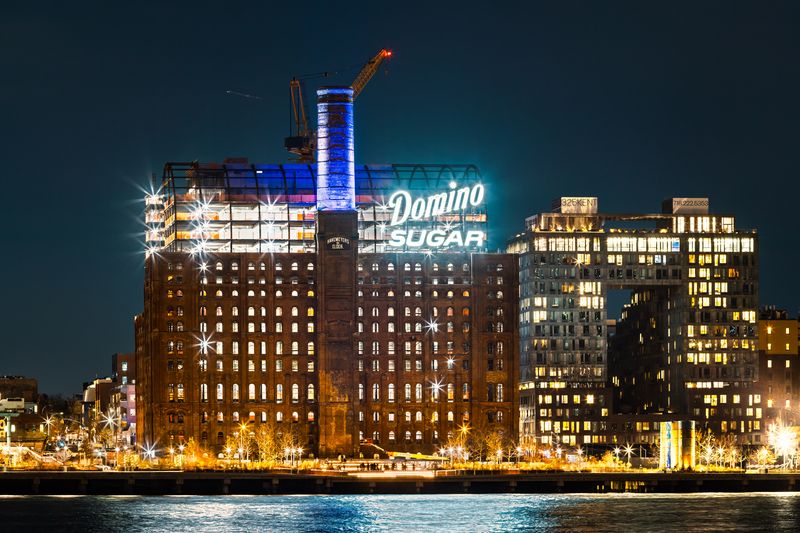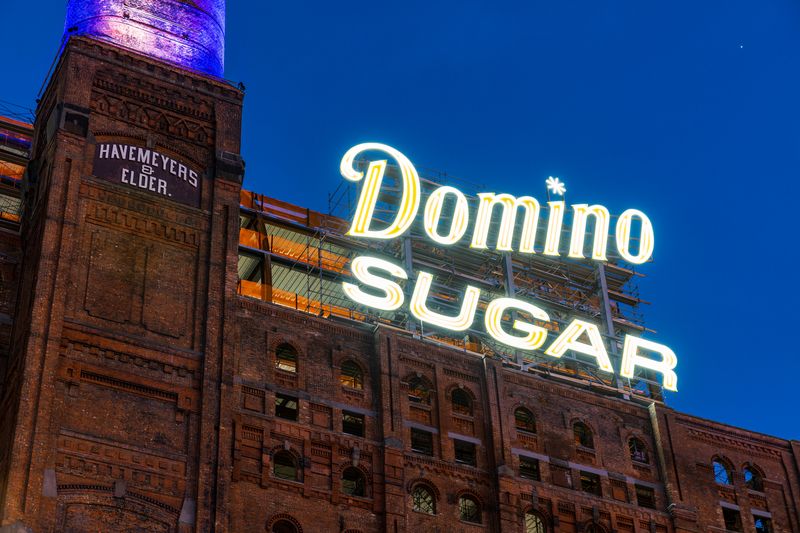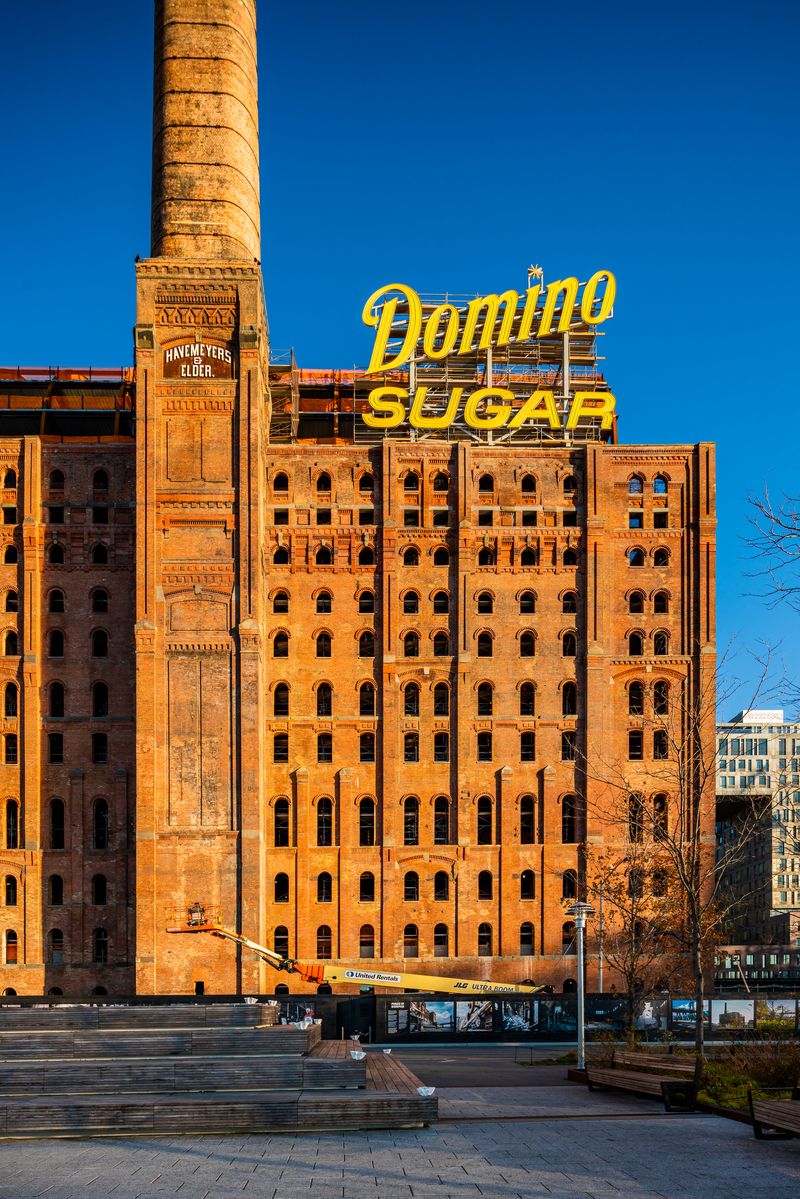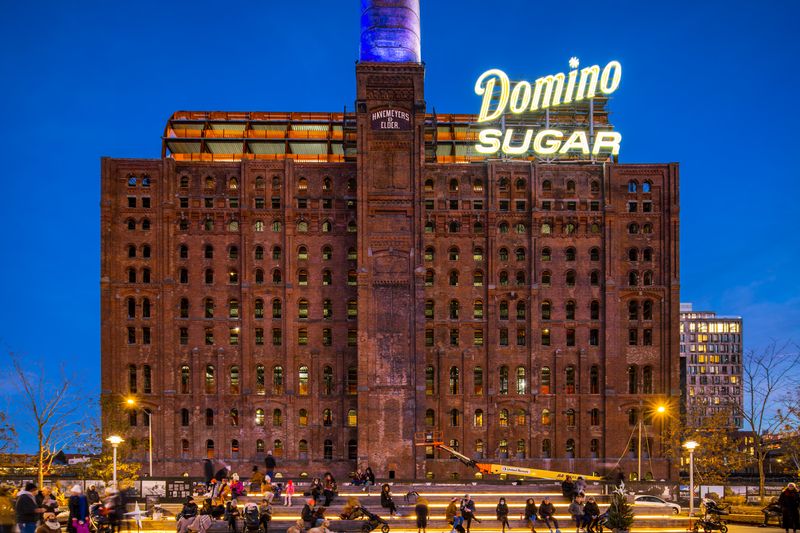See the History of Ticker-Tape Parades Beneath Your Feet on Broadway’s Canyon of Heroes
Uncover the history of NYC's confetti-covered parades that have been running since the 1880s!


For over eight decades, the iconic neon Domino Sugar sign shone like a beacon over the Brooklyn waterfront. This week, a new replica of the sign was installed and turned on for the first time atop the Domino Sugar Refinery building. Untapped New York spoke with Domino Sugar Factory historian and Brooklyn native Ward Dennis to discuss the significance of the historic sign and the impact of the Domino Sugar Factory on the local community.

Built in 1882, the Domino Sugar Refinery in Williamsburg occupied an 11-acre site along the East River. As the American Sugar Refining Company’s largest plant, it was one of several factories forming northern Brooklyn’s lucrative sugar production industry. In its heyday, sugar refineries and barrel manufacturers stretched along the river to Newtown Creek, employing thousands of local residents. At the end of the 19th century, the refinery produced 5,000 barrels of sugar a day and employed over 4,500 workers during its peak between World War I and World War II. After the 1940s, however, operations declined as alternative sweeteners such as corn syrup gained popularity and production moved up to Yonkers. Only liquid sugar was refined there by the 1990s.

After the plant’s closure in 2003, the site was cleared to make way for new development. The factory’s ancillary structures were demolished, despite their historical significance. Filter, Pan, and Finishing House was preserved. Ward Dennis, who chaired a land use committee reviewing proposals for a community board, thought the redevelopment of the site as a public park would be significant for the local community. He pointed out that when the six-acre waterside Domino Park was proposed, much of the Williamsburg and Greenpoint industrial waterfront had not been publicly accessible until 20 years prior.
Since its closure, the refinery building has been off-limits to the public while undergoing renovation. Dennis described it as a perfectly preserved marvel of historic engineering, with the shell of the building holding together filters and ovens three to four stories tall. The last time the refinery was open to the public was during the 2014 exhibition of Kara Walker’s A Subtlety, a site-specific installation underwritten by the real estate developer Two Trees and using sugar donated by Domino. Responding to the plant’s historic interior, Walker’s 35-foot tall sugar sphinx interrogated the legacy of sugarcane production in transatlantic slavery.

Today, construction is still ongoing on the Refinery, which is being transformed into a 460,000 square-foot Class A office space to house a new age of workers. The building will stand 235 feet tall and feature a new barrel-vaulted glass dome, fully rebuilt interiors, and landscaping. A key feature of the renovated building will be the reworked Domino signage on the roofline. When the redevelopment plan was proposed in 2009, the commissioners asked developers to include a place for the Domino sign, which was moved to a nearby building when its original location was demolished. Although the main refinery is protected by its landmark status, the sign was not included in that designation, placing it at possible risk. Since the original sign was not able to be restored in a safe and sustainable way, Two Trees decided to create a replica, working with signage specialists to get it as close as possible to the original design. Two Trees is currently working with Domino Sugar to find an appropriate permanent home for the original sign.
The new sign that shines today is an LED replica installed atop the building’s new glass addition, with the name “Domino Sugar” spelled out in yellow letters 43 feet 6.5 inches tall and 65 feet 8 inches wide. The replica was designed to be brighter, more energy efficient, and long-lasting, while the new aluminum letters will reduce the weight placed on the new glass structure. The bottom part of the sign, which spells out “sugar,” was installed in November 2022.

The sign’s reinstallation will be an iconic reminder of Brooklyn’s industrial history. “It was an iconic sign for drivers on F.D.R. Drive and Williamsburg Bridge for generations,” Dennis said. Domino Sugar will rejoin other landmark industrial signs, such as Silvercup Studios and the Pepsi-Cola signs in Long Island City. While the Two Trees development project seeks to renovate the refinery for Brooklyn’s changing waterfront, the new Domino Sugar signage will preserve a nostalgic symbol of the past for generations of Brooklyn residents.
Next, check out 10 Abandoned Places to Discover in Brooklyn and 10 Important Pieces of Architecture Along the East River
Subscribe to our newsletter